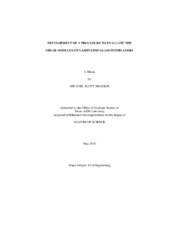| dc.description.abstract | Laminated glass is comprised of multiple glass plates coupled together in a sandwich construction through the use of a polymorphous interlayer that acts as a bonding agent between the glass plates. Laminated glass offers several advantages over monolithic glass including the ability to resist post fracture collapse, improved sound insulation, lower ultraviolent light trans-mission, and improved thermal insulation. Because the stiffness of the interlayer is often many orders of magnitude less than that of the glass, plane sections prior to loading do not remain plane throughout the laminate?s thickness after load is applied.
The behavior of laminated glass is controlled by the stiffness of the interlayer. This behavior rules out the use of classical theoretical formulations for thin plates. In such cases, it is necessary to use specially formulated equations or finite element analyses to evaluate the performance of laminated glass. Previous attempts have been made to develop procedures to quantify the interlayer stiffness for use in laminated glass design. However, there is no widely accepted technique that can be referenced for use.
It is known that the interlayer stiffness is a function of both temperature and load duration. The primary objective of this thesis is to formalize a standard procedure to estimate the in situ interlayer shear modulus through the use of nondestructive testing.
Physical experiments were carried out on simply supported laminated glass beams subject to three point loading in a temperature controlled environmental testing chamber. Strains and temperatures were recorded as a function of time. These data were used in combination with results from finite element analyses to quantify the variation of the interlayer stiffness as a function of temperature and load duration for a given laminated glass beam.
This procedure was applied to three common types of interlayer materials: freshly man-factured polyvinyl butyral (PVB), over a decade old PVB, and freshly manufactured SentryGlas Plus (SGP). Results from these efforts provide specific design guidance for laminated glass that incorporates these interlayer materials. Further, the procedure was applied to various data presented in open literature by previous researchers. In addition, a standardized procedure to estimate interlayer stiffness is provided for the development of additional interlayer properties as required. | en |


